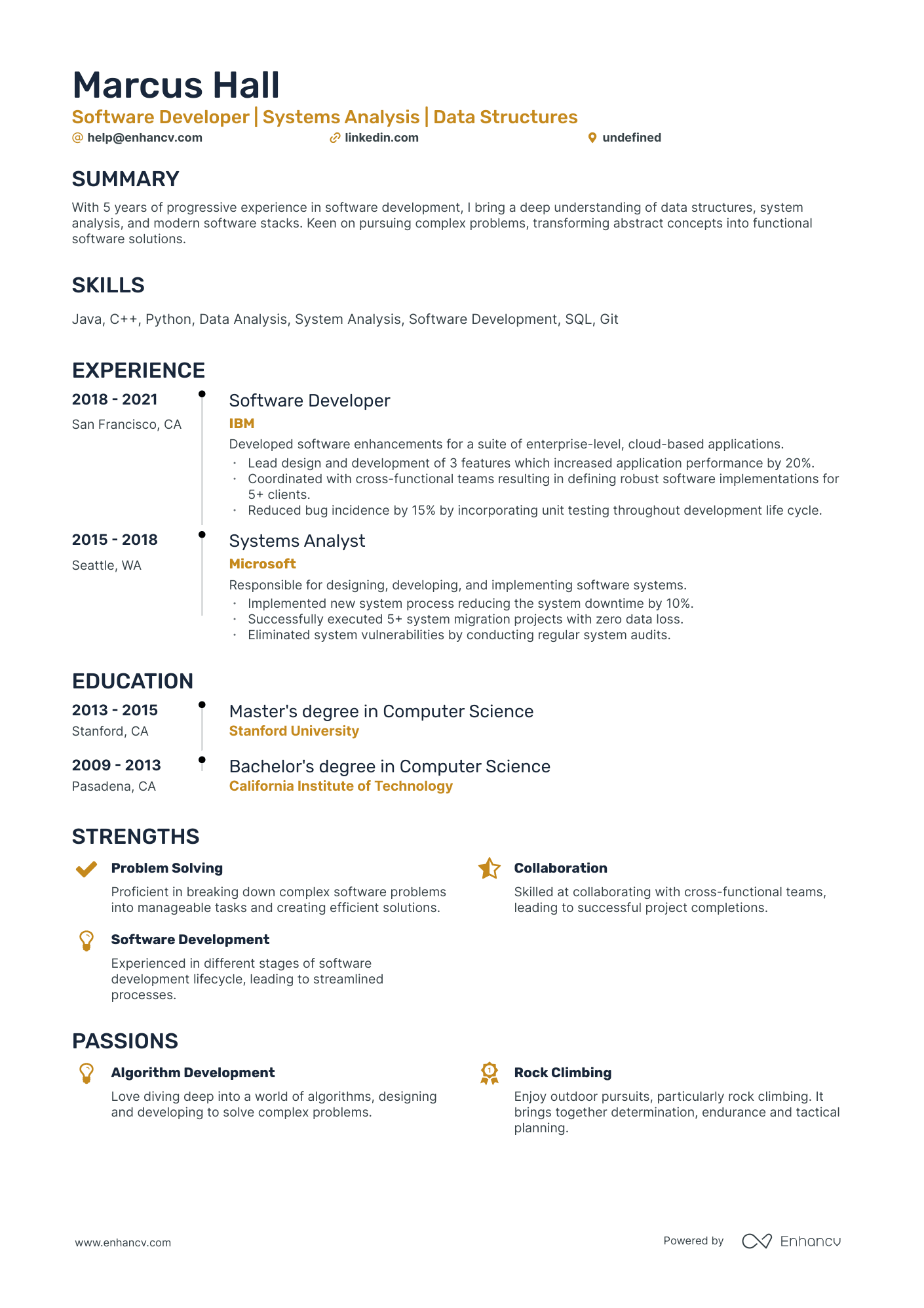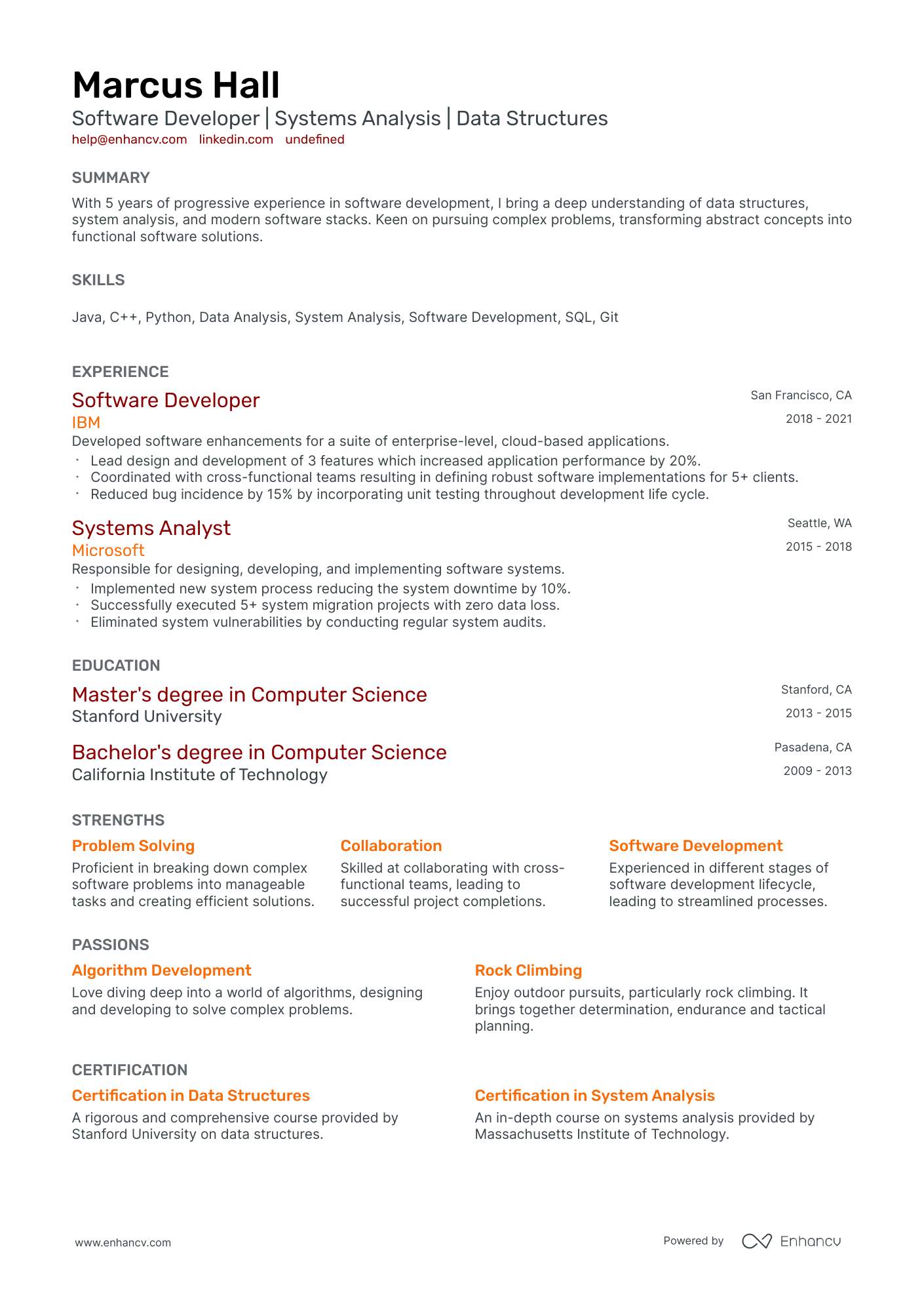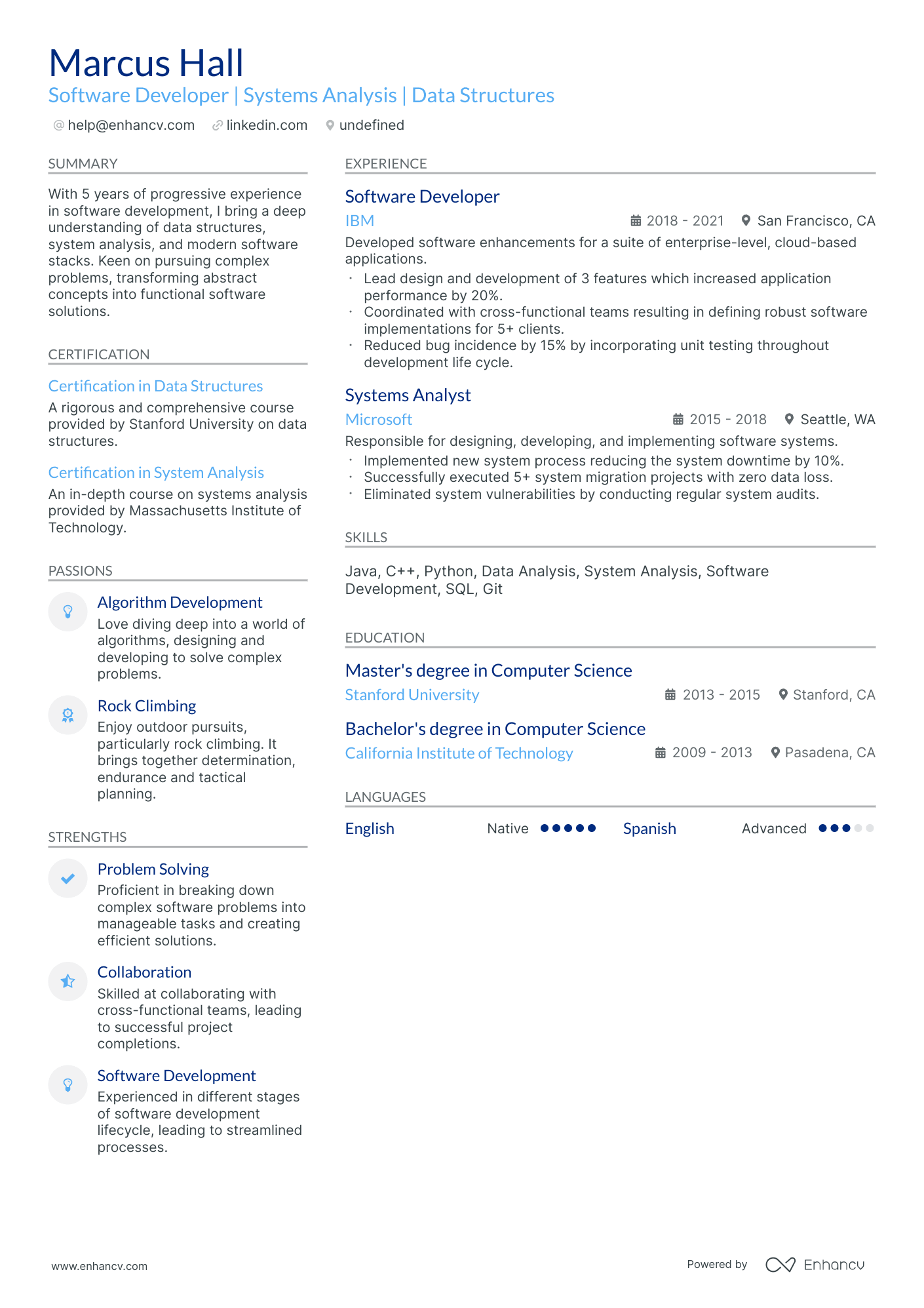One common resume challenge faced by computer science interns is effectively showcasing their technical skills in a concise manner, due to the wide range of programming languages and software development tools they might be proficient in. Our guide can assist in this by providing structured templates and clear examples on how to highlight these technical competencies effectively, focusing on relevance to the job description and demonstrating practical application.
Dive into this guide to learn how to craft a computer science internship resume that offers recruiters a clear view of your career journey:
- Draw from our computer science internship resume samples, highlighting top skills, certifications, and more.
- Illuminate the potential impact you can bring to an organization through your resume summary and experience.
- Spotlight your unique computer science internship expertise, emphasizing tangible results and standout achievements.
Recommended reads:
Tips for refining your computer science internship resume format
The resume format sets the stage for your professional narrative. Ensure it:
- Adopts the reverse-chronological format, placing your most recent experiences at the forefront. This format is ideal for those with relevant and up-to-date experience.
- Features a clear headline, making it straightforward for recruiters to access your contact details, portfolio, or current role.
- Stays concise, ideally spanning no more than two pages, focusing on relevant experiences and skills.
- Maintains its layout by being saved as a PDF, ensuring compatibility with Applicant Tracking Systems (ATS).
Each market has its own resume standards – a Canadian resume layout may differ, for example.
Upload your resume
Drop your resume here or choose a file. PDF & DOCX only. Max 2MB file size.
Pro tip
Choose a legible, professional font for your computer science internship resume, such as Arial or Calibri.
To craft a compelling business intelligence analyst resume, focus on these sections:
- A scannable header
- A snapshot of your professional persona, showcasing soft skills, achievements, and a summary or objective
- Skills that align with the job advert
- Quantifiable achievements in your experience section
- An education and technical skills section that underscores your proficiency with specific tools or software
What recruiters want to see on your resume:
- Relevant Programming Languages: Showcasing proficiency in languages specific to the internship's requirements (like Python, Java, C++, etc.)
- Technical Skills and Tools: Knowledge of tools like Git, Docker, or frameworks/libraries such as ReactJS, Node.js, TensorFlow, etc.
- Problem-Solving Capabilities: Evidence of strong analytical skills, often demonstrated through involvement in coding competitions, hackathons, or complex class projects.
- Understanding of Algorithms and Data Structures: Demonstrating strong theoretical knowledge base, typically learned in class or via self-study.
- Real-World Experience: Internships, research positions, or work on significant software or hardware projects, ideally with a link to a portfolio or GitHub profile.
Recommended reads:
Decoding the computer science internship resume experience section
Once you've settled on your resume's format, the next step is detailing your professional journey.
Many computer science internship professionals grapple with this section, especially when balancing between extensive or limited experience. Here's a roadmap to navigate this:
- Limit bullet points under each job role to six, focusing on high-impact contributions.
- Highlight achievements that resonate with the job's requirements, rather than just listing duties.
- Detail any on-the-job certifications or skills acquired and their relevance to your growth.
- Choose impactful verbs for each bullet, avoiding overused terms like "managed".
- Infuse relevant keywords from the job posting, especially in the context of accomplishments.
For more insights, explore these curated examples from seasoned computer science internship professionals:
- Led a team of 5 developers in designing and implementing a scalable web application using Java and Spring framework.
- Optimized database queries resulting in a 30% reduction in response time for a high-traffic e-commerce website.
- Developed automated testing scripts using Selenium, improving test coverage by 40%.
- Collaborated with cross-functional teams to develop an iOS mobile app, which reached over 100k downloads within the first month of launch.
- Implemented machine learning algorithms for data analysis, leading to a 25% increase in customer retention.
- Optimized codebase by refactoring existing code, resulting in a 20% improvement in app performance.
- Participated in the development of a large-scale enterprise system using C# and .NET framework, delivering a 15% increase in productivity.
- Performed code reviews and provided constructive feedback resulting in improved code quality and reduced bugs by 20%.
- Collaborated with UX designers to create intuitive user interfaces resulting in a 40% decrease in user errors.
- Designed and implemented RESTful APIs using Node.js and Express framework, handling over 10 million requests per day.
- Developed an automated deployment pipeline using Docker and Jenkins, reducing deployment time by 50%.
- Implemented real-time data processing using Apache Kafka, resulting in a 30% improvement in data synchronization.
- Collaborated with QA team to identify and fix critical bugs, reducing the number of production issues by 40%.
- Developed and maintained scalable web applications using Ruby on Rails, supporting a user base of over 100,000.
- Implemented continuous integration and automated testing using Jenkins, resulting in a 50% reduction in manual testing efforts.
- Worked on the development of a financial management system, integrating accounting modules resulting in streamlined processes and improved accuracy.
- Collaborated with UI designers to create responsive and user-friendly interfaces, resulting in a 25% increase in user engagement.
- Implemented security measures to protect sensitive user data, resulting in zero security breaches or data leaks.
- Developed front-end interfaces using HTML, CSS, and JavaScript, ensuring cross-browser compatibility and responsive design.
- Optimized website performance by implementing caching mechanisms resulting in a 30% reduction in page load time.
- Collaborated with UX designers to conduct user research and usability testing, leading to a 20% improvement in user satisfaction.
- Designed and implemented scalable microservices architecture using Kubernetes, handling millions of transactions per day.
- Developed and deployed machine learning models for fraud detection, reducing fraudulent activities by 50%.
- Collaborated with DevOps team to automate infrastructure provisioning using Terraform, resulting in a 60% reduction in deployment time.
- Developing mobile applications for iOS and Android platforms using React Native, reaching over 100k active users monthly.
- Implemented offline functionality using SQLite and data synchronization with RESTful APIs resulting in continuous app usage even without an internet connection.
- Collaborating with UX designers to create visually appealing and intuitive interfaces, resulting in a 40% increase in user engagement.
- Led a team of 8 developers in the design and development of a cloud-based CRM system using Java and Spring Boot.
- Implemented data analytics features using Apache Spark, resulting in data-driven customer insights and a 20% boost in sales.
- Collaborated with product managers to define project requirements and deliver high-quality software solutions on time and within budget.
Quantifying impact on your resume
<ul> <li>Include the number of programming languages you're proficient in to demonstrate your broad range of technical skills.</li> <li>List the exact quantity of software or applications you have developed or contributed to, which displays your hands-on experience.</li> <li>Mention the number of projects you've completed on time and on budget to illustrate your project management skills.</li> <li>Specify how much efficiency was increased or how much time was saved through your optimization efforts or innovative solutions.</li> <li>State the size of datasets you have worked with to show your ability to handle complex information.</li> <li>Highlight the number of team members you have worked with or led in a project, demonstrating teamwork and leadership skills.</li> <li>Detail the percentage improvement in performance, reliability, or security achieved in your work to underscore your impact.</li> <li>Enumerate any quantifiable achievements from participating in coding competitions or hackathons, showing your competitive edge and commitment to constant learning.</li>
Crafting the experience section for novice computer science internship candidates
Lack of extensive experience doesn't equate to an empty resume. Here's how you can enrich your experience section:
- Volunteer Roles: Community involvement often equips you with valuable interpersonal skills, and sometimes even technical ones, relevant to the job.
- Academic Projects: Highlight significant university projects that contributed to the field, showcasing your hands-on experience.
- Internships: Even short-term internships can be invaluable. If they're pertinent to the role, they deserve a spot on your resume.
- Past Jobs: Even if unrelated to the computer science internship, these roles can demonstrate transferable skills that are beneficial for the position.
Pro tip
The wording of your experience items should be with active, power verbs, instead of adjectives. Always be specific about each item you detail, and never overuse vague buzzwords. You weren't just "organized", but rather "Enhanced internal work processes to optimize operational management by 65%".
Highlighting your hard and soft skills on your computer science internship resume
The skills section of your computer science internship resume should showcase your capabilities that align with job requirements.
Your hard skills, or technical skills, demonstrate your proficiency with technological innovations and specific software. On the other hand, your soft skills illustrate how you'd excel in the workplace environment with personal attributes like resilience, negotiation, and organization.
For a well-rounded computer science internship resume, it's essential to include both. Here's how to craft a standout skills section:
- Prioritize skills listed at the top of the job advert.
- Highlight unique skills you've honed over time.
- Choose soft skills that resonate with the company or department culture.
- Address essential job requirements by listing key skills for the computer science internship role that haven't been mentioned elsewhere in your resume.
Check out our sample skill list for computer science internship to get ideas on the most sought-after hard and soft skills in the industry.
Top skills for your computer science internship resume:
Python
Java
C++
SQL
JavaScript
HTML/CSS
Git
Linux
Data Structures
Algorithms
Communication
Teamwork
Problem-solving
Adaptability
Time Management
Critical Thinking
Attention to Detail
Creativity
Initiative
Work Ethic
Pro tip
The placement of your skills section should align with its importance. If it's a showcase of your most significant strengths, position it prominently near the top of your resume.
Choosing the right certifications and education for your computer science internship resume
Your education section can highlight skills and experiences perfect for the job.
- List college or university degrees with the school name and dates.
- If you're still studying, mention your expected graduation date.
- Think twice before adding unrelated degrees. Space on your resume is precious.
- Discuss educational achievements if they boost your job relevance.
There are many certifications out there. Which ones should you include?
- List your main degree in a separate section with the school name and dates.
- Only add certifications that highlight your skills and experience.
- Place unique or recent certifications near the top.
- Add a brief description to certifications if it helps show your skills.
Remember, it's not about quantity but relevance.
Best certifications to list on your resume
Pro tip
Listing your relevant degrees or certificates on your computer science internship resume is a win-win situation. Not only does it hint at your technical capabilities in the industry, but also at a range of soft skills, including perseverance, adaptability, and motivation.
Recommended reads:
best practices for your computer science internship resume summary or objective
How do you know if you should include a resume summary or a resume objective?
- Resume summaries are ideal for computer science internship professionals with more experience, who'd like to give a quick glimpse of their biggest career achievements in the top one-third of their resumes.
- On the other hand, resume objectives serve as a road map to the applicant's aspirations. Candidates use the objective as the North Star of their career (or, how they see themselves in the role in the next few years).
Both could be the perfect fit for your computer science internship resume, depending on your experience.
Here's how candidates for the computer science internship job structure their summaries and objectives.
Resume summary and objective examples for a computer science internship resume
Extra sections to include in your computer science internship resume
What should you do if you happen to have some space left on your resume, and want to highlight other aspects of your profile that you deem are relevant to the role?
Add to your computer science internship resume some of these personal and professional sections:
- Passions/Interests - to detail how you spend both your personal and professional time, invested in various hobbies;
- Awards - to present those niche accolades that make your experience unique;
- Publications - an excellent choice for professionals, who have just graduated from university or are used to a more academic setting;
- < a href="https://enhancv.com/blog/volunteering-on-resume/"> Volunteering - your footprint within your local (or national/ international) community.
Key takeaways
- A clear resume layout helps present your info well.
- Use all main resume sections to show how you fit the job.
- Detail specific skills or tasks and their impact.
- Show your personality through interests or hobbies.
- List certifications to back up your technical skills.










